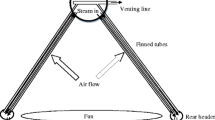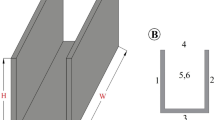Abstract
This article studies how the natural convection in the annular space between a pair of cylinders is affected by a number of parameters including Rayleigh number, type, number and geometry of fins, and injection of water particles. To this aim, the finite volume method is employed. Various fin types including a linear fin with an arbitrary number of blades, annular fins with different pitch values, straight and curved twisting fins, and conical fins are considered. The results indicate that by adding to the quantity of fins and decreasing the distance between them, the effective thermal conductivity coefficient grows compared to the case without fins. The shape of these fins plays a significant role in the amount of the heat transfer from the annular space such that the highest percentage increase, i.e. 67%, belongs to the curved twisting fin. When the two cylinders are not concentric, the effective thermal conductivity coefficient grows which can be further increased by increasing the Rayleigh number. Using two-phase modeling, it is observed that in the presence of water particles, the heat transfer from the cylindrical space is reduced. Compared to the single-phase scenario, this corresponds to a reduction of about 70% and 23% in the case of four linear fins and annular fins with a pitch of 20 mm, respectively.










Similar content being viewed by others
Abbreviations
- \(k_{{eff}}\) :
-
Effective thermal conductivity coefficient, W/m2.K
- \({\text{h}}\) :
-
Convective heat transfer coefficient, \(~{\text{W/m}}^{{\text{2}}} {\text{K}}\)
- \(D\) :
-
External tube diameter, \({\text{m}}\)
- \(L\) :
-
Length of the tube, \({\text{m}}\)
- \(Nu\) :
-
Nusselt number
- \(P\) :
-
Pressure, \(~{\text{kPa}}\)
- \(Ra\) :
-
Rayleigh number
- \(T\) :
-
Temperature, \(~{\text{K}}\)
- \(V\) :
-
Velocity, \(~{\text{m/s}}\)
- \(d\) :
-
Inner tube diameter, \({\text{m}}\)
- \(f\) :
-
Volume fraction
- \(g\) :
-
Gravity acceleration, \(~{\text{m/s}}^{{\text{2}}}\)
- \(k\) :
-
Thermal conductivity coefficient, W/m.K
- \(q\) :
-
Heat transfer rate per tube’s unit length, \(~{\text{W/m}}\)
- \(t\) :
-
Time \(~{\text{s}}\)
- \(\alpha\) :
-
Thermal diffusion coefficient, \(~{\text{m}}^{{\text{2}}} {\text{/s}}\)
- \(\beta\) :
-
Thermal expansion coefficient, \({\text{K}}^{{ - 1}}\)
- \(\mu\) :
-
Dynamic viscosity, Pa.s
- \(\rho\) :
-
Density, \(~{\text{kg/m}}^{{\text{3}}}\)
- \(\vartheta\) :
-
Kinetic viscosity \(~{\text{m}}^{{\text{2}}} {\text{/s}}\)
- \(H\) :
-
Hot
- \(c\) :
-
Cold
- \(m\) :
-
Mixture
- \(o\) :
-
Operating condition
References
Acharya S, Dash SK (2020) Turbulent natural convection heat transfer from a vertical hollow cylinder suspended in air: a numerical approach. Therm Sci Eng Progress 15:100449. https://doi.org/10.1016/j.tsep.2019.100449
Choi C, Jeong S, Ha MY, Yoon HS (2014) Effect of a circular cylinder’s location on natural convection in a rhombus enclosure. Int J Heat Mass Transf 77:60–73. https://doi.org/10.1016/j.ijheatmasstransfer.2014.04.071
Gandhi MS, Sathe MJ, Joshi JB, Vijayan PK (2011) Two phase natural convection: CFD simulations and PIV measurement. Chem Eng Sci 66:3152–3171
Ha MY, Kim JG (2004) Numerical simulation of natural convection in annuli with internal fins. KSME Int J 18(4):718–730. https://doi.org/10.1007/bf02983656
Hata K, Liu Q, Nakajima T (2019) Natural convection heat transfer from a vertical single cylinder with helical wire spacer in liquid sodium. Nucl Eng Des 341(1):73–90. https://doi.org/10.1016/j.nucengdes.2018.10.019
Kitamura K, Mitsuishi A, Suzuki T, Kimura F (2016) Fluid flow and heat transfer of natural convection induced around a vertical row of heated horizontal cylinders. Int J Heat Mass Transf 92:414–429. https://doi.org/10.1016/j.ijheatmasstransfer.2015.08.086
Liu J, Liu H, Zhen Q, Lu W-Q (2017) Numerical investigation of the laminar natural convection heat transfer from two horizontally attached horizontal cylinders. Int J Heat Mass Transf 104:517–532. https://doi.org/10.1016/j.ijheatmasstransfer.2016.08.075
Mirabedin SM, Farhadi F (2016) Natural convection in circular enclosures heated from below for various central angles. Case Stud Therm Eng 8:322–329. https://doi.org/10.1016/j.csite.2016.08.007
Nada SA (2008) Experimental Investigation of natural convection heat transfer in horizontal and inclined annular fluid layer. Heat Mass Tran 44:929–936
Nada SA, Said MA (2019) Effects of fins geometries, arrangements, dimensions and numbers on natural convection heat transfer characteristics in finned-horizontal annulus. Int J Therm Sci 137:121–137. https://doi.org/10.1016/j.ijthermalsci.2018.11.026
Niezgoda-Żelasko B, Żelasko J (2014) Free and forced convection on the outer surface of vertical longitudinally finned tubes. Exp Therm Fluid Sci 57:145–156. https://doi.org/10.1016/j.expthermflusci.2014.04.014
Park YG, Ha MY, Choi C, Park J (2014) Natural convection in a square enclosure with two inner circular cylinders positioned at different vertical locations. Int J Heat Mass Transf 77:501–518. https://doi.org/10.1016/j.ijheatmasstransfer.2014.05.041
Peskin CS (1972) Flow patterns around heart valves: a numerical method. J Comput Phys 10(2):252–271. https://doi.org/10.1016/0021-9991(72)90065-4
Reddy AS, Akella S, Prasad A (2014) Experimental study of free convection heat transfer from array of vertical tubes at different inclinations. Int J Emerg Technol Adv Eng 4(3)
Senapati JR, Dash SK, Roy S (2017) Numerical investigation of natural convection heat transfer from vertical cylinder with annular fins. Int J Therm Sci 111:146–159. https://doi.org/10.1016/j.ijthermalsci.2016.08.019
Sparrow E, Boessneck D (1983) Effect of transverse misalignment on natural convection from a pair of parallel, vertically stacked, horizontal cylinders. J Heat Transfer 105(2):241–247. https://doi.org/10.1115/1.3245569
Tokura I, Saito H, Kishinami K, Muramoto K (1983) An experimental study of free convection heat transfer from a horizontal cylinder in a vertical array set in free space between parallel walls. J Heat Transfer. https://doi.org/10.1115/1.3245526
Totala NB, Shimpi MV, Shete NL, Bhopate VS (2013) Natural convection characteristicsin vertical cylinder. Int J Eng Sci 3(8):27–31
Author information
Authors and Affiliations
Corresponding author
Additional information
Publisher's Note
Springer Nature remains neutral with regard to jurisdictional claims in published maps and institutional affiliations.
Rights and permissions
About this article
Cite this article
Farahani, S.D., Sheikhi, R. & Kisomi, M.S. Natural convection heat transfer in the annular space by using novel fins and water droplets injection. Braz. J. Chem. Eng. 39, 441–454 (2022). https://doi.org/10.1007/s43153-021-00123-4
Received:
Revised:
Accepted:
Published:
Issue Date:
DOI: https://doi.org/10.1007/s43153-021-00123-4




